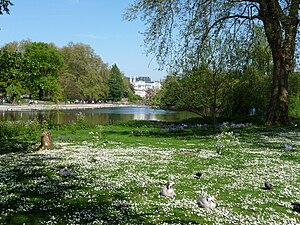 |
| English: St. James’s Park in London Deutsch: St. James’s Park in London (Photo credit: Wikipedia) |
St James’s Park
- Location: St James’s Park sits in front of Buckingham Palace, framed by the palace to the west, Green Park to the north west, Horseguards Parade to the east and Birdcage Walk to the south. It can be considered to form the eastern edge of a near contiguous green swathe across central London, flowing into Green Park, Hyde Park and Kensington Gardens to the west.
- Character: Although compact, the park is marginally larger than its neighbour Green Park at 57 acres. It consists of semi classic formal parkland criss-crossed with paths and is dominated by a lake which splits the park in two. The Mall runs through its northern edge and effectively serves as its boundary with Green Park
- Attractions: Whilst the park is surrounded by attractions such as the aforementioned Buckingham Palace, The Mall (the ceremonial route to the palace) and Horseguards Parade its does also offer a horticultural haven within its boundaries. Visitors can enjoy the flower beds of the Memorial Gardens just outside Buckingham Palace, stunning views of the palace from numerous vantage points and St James’s Park lake with its wildfowl including pelicans
- History: The park was established by Henry VIII on the marshy banks of the now defunct River Tyburn, which flowed down from Hampstead through the area now known as Marylebone (after St Mary by the Bourne), to the west of what was referred to as York Place (now Whitehall), with the intention of creating gardens for a new royal palace there. Following a similar evolution to many of London’s Royal Parks, the lands were subsequently drained and landscaped under the reign of James I who, more unusually, kept exotic animals on them. They were then landscaped and formalised further by Charles II, taking influences from French Royal Gardens of he time, with linear features such as a new central canal. Early in 19th century however, the Prince Regent, later George IV, commissioned John Nash to once again re-landscape the park, this time removing these linear aspects from Charles II’s plans and, in the contemporary styles of the age, introduce more organic, romantic and winding features, turning the canal into a lake for example, whilst creating the The Mall as a stately approach to Buckingham Palace.
Greenwich Park
- Location: Located in Greenwich, South East London, the park is surrounded on its southern edges by the open grassland space of Blackheath. To the north is the National Maritime Museum, the Royal Naval College housing the University of Greenwich, and the River Thames beyond. The park is famously situated on the Prime Meridian at 0 degrees longitude.
- Character: Covering 180 acres it is a major constituent of the Maritime Greenwich world heritage site. The park itself is on split levels on a hill side which slopes down to the Thames, providing views down onto central and eastern London. Within the park can be found formal herb and rose gardens, orchards, a deer park and lakes.
- Attractions: At the heart of Greenwich Park is the historical and scientific hub of the Royal Observatory which is the most notably the origin of the Prime Meridian (which runs through the park) as well as being a branch of the Maritime Museum. Visitors can also glimpse deer, visit the parks famous sundial, view Roman ruins, or make use of the park’s tennis courts and boating lake.
- History: Dating from 1433 Greenwich is the oldest of the Royal Parks as well as being the first to be enclosed. It came into the possession of the monarchy with Henry VI in the 15th century but it was Charles II who later created the Royal Observatory (with the help of Sir Christopher Wren) on the site of the derelict Greenwich Castle (originally built by Duke of Gloucester). The buildings known as the Royal Naval college today originated as Greenwich hospital and were built on the site of the Tudor Palace of Placentia (birthplace and home to Tudor monarchs) in the late 17th century. The area was turned into a deer park by Henry VIII, who was born in the adjoining palace, and subsequently enclosed by James I when they were formally landscaped in the 17th century. As with many of the other London parks Greenwich has been more recently in the spotlight as a venue for the London 2012 Olympics, hosting its equestrian elements.
If you are looking to move to London or are already based in the area and are looking for digital marketing services then visit Estate Agents Marylebone or Web Design London respectively.

No comments:
Post a Comment